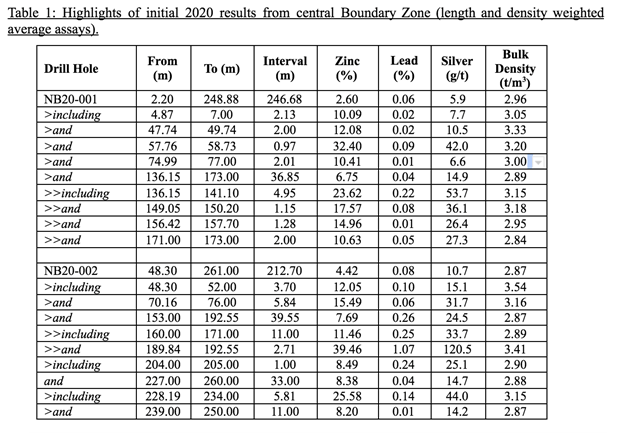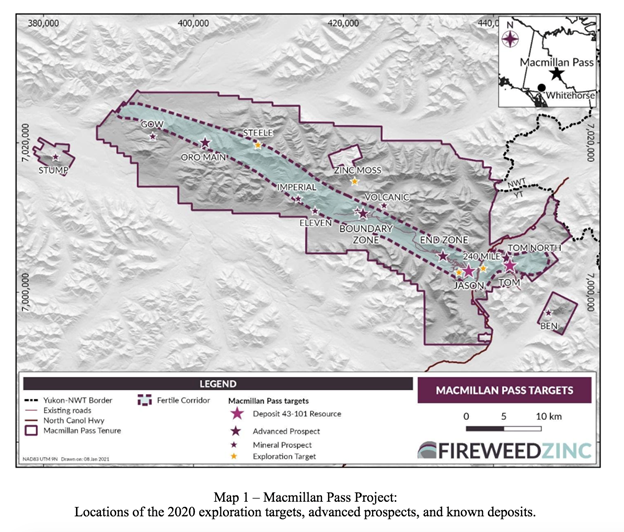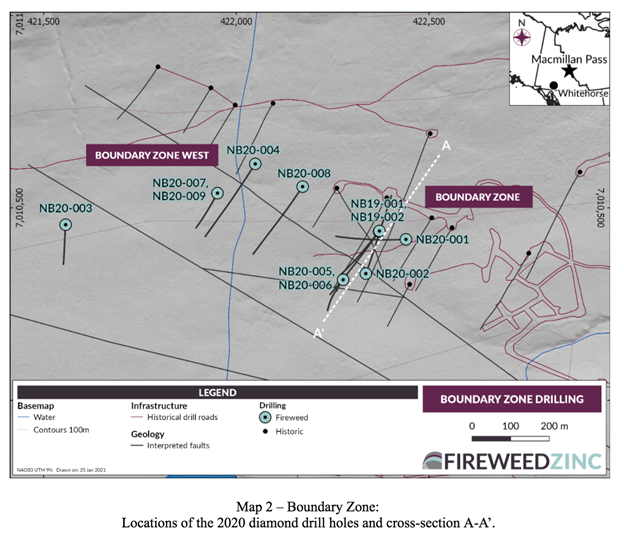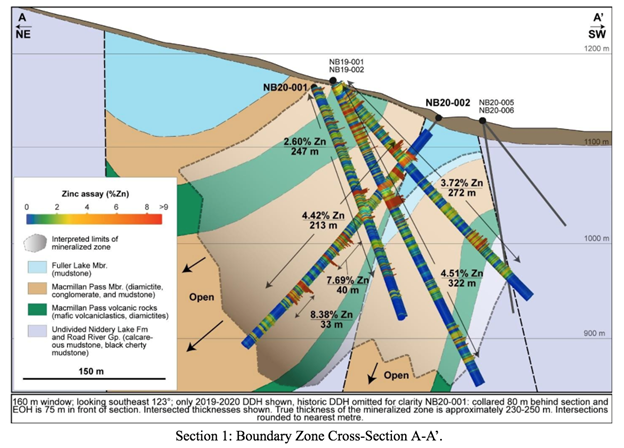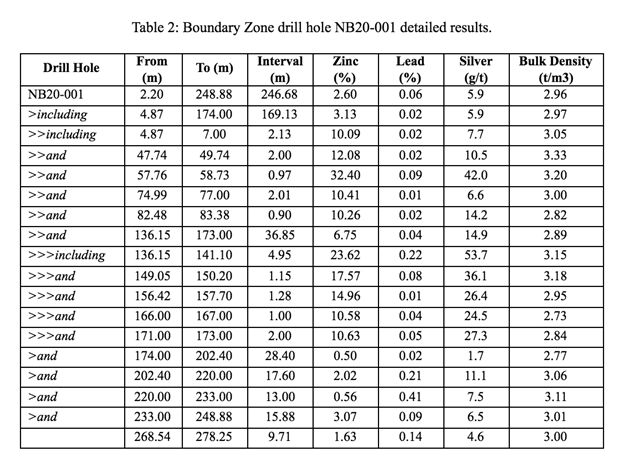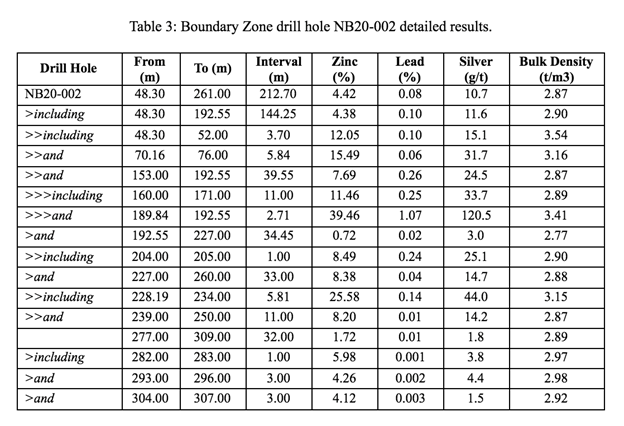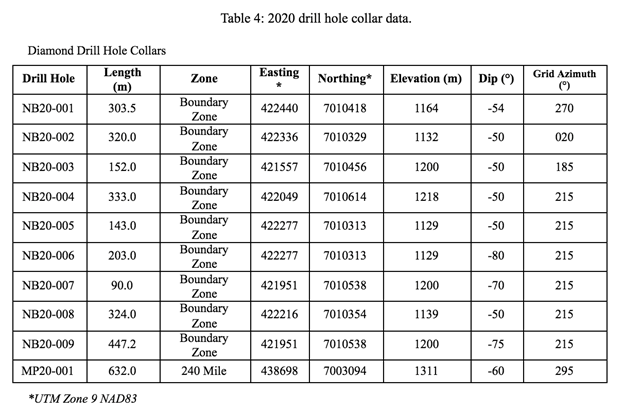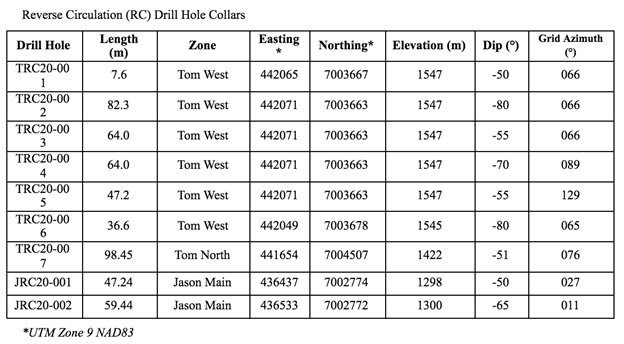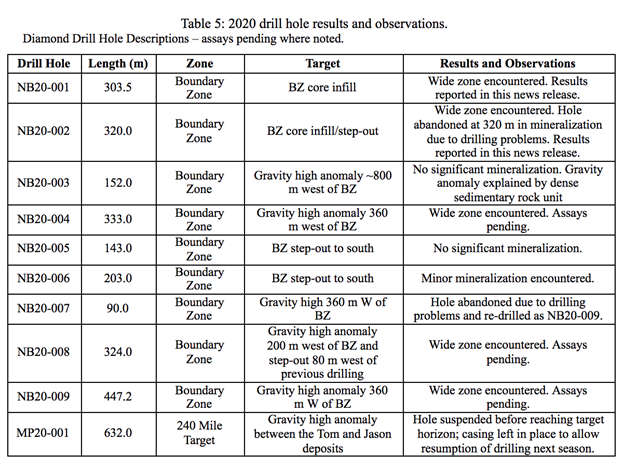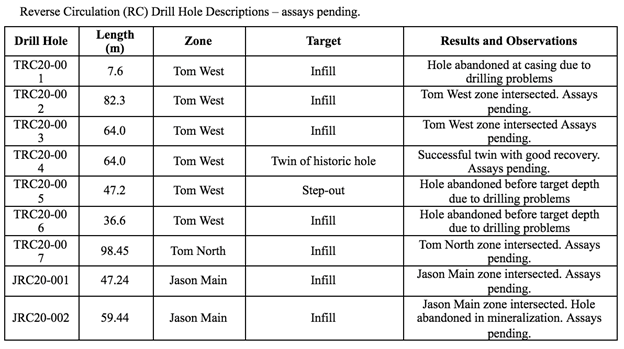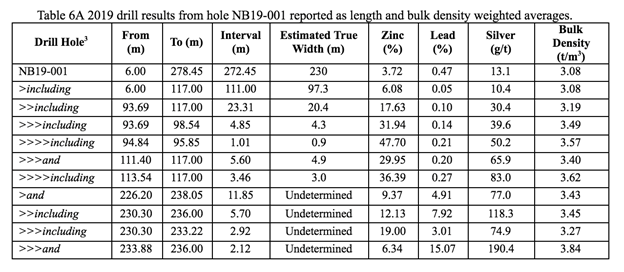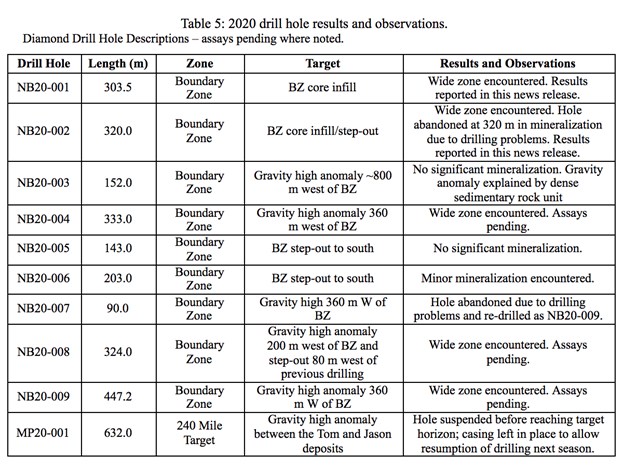Fireweed Intersects 4.42% Zinc over 212.70 m Including 25.58% Zinc over 5.81 m at Boundary Zone
Vancouver, British Columbia: FIREWEED ZINC LTD. (“Fireweed”) (TSXV: FWZ) is pleased to announce the first results from the 2020 drilling at the Macmillan Pass Project in Yukon, Canada. These results are from Boundary Zone, located 15 road kilometres west of the Tom-Jason deposits (see Map 1).
Highlights
- Significant assays over wide sections have been received from the first two diamond drill holes, NB20-001 and NB20-002, drilled in the central Boundary Zone area.
- Significant assays over wide sections have been received from the first two diamond drill holes, NB20-001 and NB20-002, drilled in the central Boundary Zone area.
- Hole NB20-002 intersected 4.42% Zinc, 0.08% Lead and 10.7 g/t Silver over 212.70 m, including 25.58% Zinc, 0.14% Lead and 44.0 g/t Silver over 5.81 m.
- Hole NB20-001 intersected 2.60% Zinc, 0.06% Lead and 5.9 g/t Silver over 246.68 m from surface including 23.62% Zinc, 0.22% Lead and 53.7 g/t Silver over 4.95 m.
- Assays from other holes including the new discovery at Boundary Zone West are pending.
- Hole NB20-002 intersected 4.42% Zinc, 0.08% Lead and 10.7 g/t Silver over 212.70 m, including 25.58% Zinc, 0.14% Lead and 44.0 g/t Silver over 5.81 m.
- Hole NB20-001 intersected 2.60% Zinc, 0.06% Lead and 5.9 g/t Silver over 246.68 m from surface including 23.62% Zinc, 0.22% Lead and 53.7 g/t Silver over 4.95 m.
- Assays from other holes including the new discovery at Boundary Zone West are pending.
CEO Statement
Brandon Macdonald, CEO, stated “These first assays have been a long time coming due to slow turn around at the lab while they operate under COVID-19 limitations. The assays reported here are from the first two holes drilled in the central Boundary Zone area in 2020. We are pleased to see more good grades extending this wide zone of mineralization with very high-grade sections to depth in the central Boundary Zone area. Overall a belated but great start to the 2020 drill assays.”
2020 Drill Results
The 2020 drill program was completed in October, but these are the first assays to be announced due to slow turn around at the lab operating under COVID-19 limitations. Infill and step-out drilling at Boundary Zone (Map 2) has successfully encountered wide zones of zinc-lead mineralization, significantly expanding the extent of the known mineralization. Drill hole NB20-002, reported in this news release, was drilled obliquely, and in the opposite direction to previous drilling and extends central Boundary Zone 150 m beyond previously drilled mineralization in this direction. This 150 m extension includes high-grade zinc mineralization, such as the 33 m intersection of 8.38% Zinc (227-260 m) that includes 5.81 m of 25.58% Zinc (Table 1). Central Boundary Zone now extends from surface down to 300 m. The zone remains open at depth as hole NB20-002 was terminated in mineralization due to drilling difficulties and would otherwise have been drilled deeper.
At central Boundary Zone, Fireweed drill holes from 2020 (NB20-001 and NB20-002), and 2019 (NB19-001 and NB19-002) were all drilled at different azimuths or dips (see Map 2 and Section 1) to test whether vein orientations are biasing grades in drill holes oriented near-parallel to the veins. Consistent average zinc grades throughout all four holes suggest that there is not a significant grade bias that is dependent on drill orientation and that the mineralization comprises an approximately 230-250 m thick stratabound sequence with vein stockworks, breccias and replacement-style zinc mineralization. True widths of individual cm- to m-scale veins intersected in NB20-001 and NB20-002 vary greatly from 20% to 95% of intersected thicknesses but the overall true thickness of central Boundary Zone is 230-250 m.
A total of nine holes were drilled at Boundary Zone this season for 2,948 m (Map 2 and Table 4). Additional 2020 drill holes targeted a ground-gravity high anomaly surveyed in 2020 and resulted in the discovery of new wide sections of pyrite-sphalerite-galena mineralization, extending Boundary Zone at least 360 m to the west in a new discovery named Boundary Zone West. Assays for the discovery holes at Boundary Zone West are pending and descriptions of all holes drilled in the 2020 season are in Table 5.
Boundary Zone Potential
There is no mineral resource for Boundary Zone yet and the zone is not included in the current mineral resource estimate for the property (described in Fireweed news release dated January 10, 2018). Boundary Zone has potential to be mined in an open pit with a low strip ratio and to be upgraded through low cost, pre-concentration ore sorting processes (see Fireweed news release dated July 31, 2019). Recent drill results at Boundary Zone along with Tom North Zone and End Zone (see Fireweed news releases dated August 20 and September 10, 2019, and November 15 and 29, 2018) represent potential for expansion of the large current mineral resources and improvement of Macmillan Pass project economics described in the current Preliminary Economic Assessment (PEA) (see Fireweed news release dated May 23, 2018).
Boundary Zone Background
Boundary Zone mineralization consists of sphalerite-siderite-pyrite and minor galena in veins, stockworks, disseminations, and as replacement of matrix and clasts within coarse clastic rocks. Drilling in 2020 at Boundary Zone West also identified stratiform mineralized sequences similar to the Tom and Jason deposits (see news release dated November 24, 2020).
Historical exploration work at Boundary Zone included geochemical and geophysical surveys as well as 24 drill holes that defined a central 200 x 800 m mineralized zone of zinc (-lead-silver) mineralization within a broader system over 2 km in strike length. Historical length-weighted average intersections1 such as 224.0 m of 2.50% zinc and 0.30% lead, including 4.5 m of 16.40% zinc, are consistent with recent Fireweed drilling and demonstrated potential for bulk tonnage open pit mineralization.
In 2019, Fireweed drilled two holes into the central part of the known Boundary Zone mineralization. Both holes intersected wide zones of high-grade replacement-style and vein- and breccia-hosted zinc mineralization, including 100.0 m (true width) of 8.73% zinc from surface including 6.4 m of 43.53% zinc within 230.0 m of 4.51% zinc (see Tables 6A, 6B and Fireweed news release dated November 5th, 2019).
Notes on sampling, assaying, and data aggregation:
The diamond drill core logging and sampling program was carried out under a rigorous quality assurance / quality control program using industry best practices. Drill intersections in this release are all HQ3 (split tube) size core (61.1mm / 2.4-inch diameter) with recoveries typically above 85%. After drilling, core was logged for geology, structure and geotechnical characteristics, marked for sampling, and photographed on site. The cores for analyses were marked for sampling based on geological intervals with individual samples 1.5 metres or less in length. Drill core from the Boundary Zone was cut lengthwise in half with a core saw; half-core was sent for assays reported in this news release, and the other half is stored on site for reference. Bulk density was determined on site for the entire length of each sample assayed by measurement of mass in air and mass in water. Sample duplicate bulk density determinations and in-house bulk density standard determinations were each made at a rate of 5%. Since 2017, four in-house bulk density standards (mineralized drill core from the Tom deposit that span a range of densities) have been used and show an acceptable long-term precision. Certified standard masses are used to calibrate the scale balance used for bulk density determinations.
A total of 5% assay standards or blanks and 5% core duplicates are included in the sample stream as a quality control measure and are reviewed after analyses are received. Standards and blanks in 2020 drill results to date have been approved as acceptable. Duplicate data add to the long-term estimates of precision for assay data on the project and precision for drill results reported is deemed to be within acceptable levels. Samples were sent to the Bureau Veritas preparation laboratory in Whitehorse, Yukon, where the samples were crushed and a 500 g split was sent to the Bureau Veritas laboratory in Vancouver, B.C to be pulverized to 85% passing 200 mesh size pulps. Clean crush material was passed through the crusher and clean silica was pulverized between each sample. The pulps were analyzed by 1:1:1 Aqua Regia digestion followed by Inductively Coupled Plasma Mass Spectrometry (ICP-ES/ICP-MS) multi-element analyses (BV Code AQ270). All samples were also analyzed for multiple elements by lithium borate fusion and X-ray fluorescence analysis (XRF) finish (BV Code LF725). Over-limit Pb (>25.0%) and Zn (>24.0%) were analyzed by lithium borate fusion with XRF finish (BV Code LF726). Silver is reported in this news release by method AQ270, and zinc and lead are reported by LF725 or LF726. Bureau Veritas (Vancouver) is an independent, international ISO/IEC 17025:2005 accredited laboratory.
Results in this news release are length and bulk-density weighted averages as would be used in a Mineral Resource estimate. Readers are cautioned that in Fireweed news releases in prior years, only length weighted assay averages were reported which may result in slightly lower (under reported) average values. To allow comparison of 2019 Boundary Zone drilling with 2020 results, 2019 intersections from holes NB19-001 and NB19-002 have been re-stated in Tables 6A and 6B as length and bulk-density weighted averages (originally reported in Fireweed news releases dated 16th October and 5th November 2019). Length and bulk-density weighted averages have been reported as these most accurately represent the average metal-content of the intersections.
Qualified Person Statement
Technical information in this news release has been approved by Gilles Dessureau, P.Geo, Vice President Exploration and a ‘Qualified Person’ as defined under Canadian National Instrument 43-101.
About Fireweed Zinc Ltd. (TSXV: FWZ)
Fireweed Zinc is a public mineral exploration company focused on zinc and managed by a veteran team of mining industry professionals. The Company is advancing its district-scale 940 km2 Macmillan Pass Project in Yukon, Canada, which is host to the 100% owned Tom and Jason zinc-lead-silver deposits with current Mineral Resources and a PEA economic study (see Fireweed news releases dated January 10, 2018, and May 23, 2018, respectively, and reports filed on www.sedar.com for details) as well as the Boundary Zone, Tom North Zone and End Zone which have significant zinc-lead-silver mineralization drilled but not yet classified as mineral resources. The project also includes large blocks of adjacent claims (MAC, MC, MP, Jerry, BR, NS, Oro, Sol, Ben, and Stump) which cover exploration targets in the district where previous and recent work identified zinc, lead and silver prospects, and geophysical and geochemical anomalies in prospective host geology.
Additional information about Fireweed Zinc and its Macmillan Pass Zinc Project including maps and drill sections can be found on the Company’s website at www.FireweedZinc.comand at www.sedar.com.
ON BEHALF OF FIREWEED ZINC LTD.
“Brandon Macdonald”
CEO & Director
Neither the TSX Venture Exchange nor its Regulation Services Provider (as that term is defined in the policies of the TSX Venture Exchange) accepts responsibility for the adequacy or accuracy of this release.
Cautionary Statements
This news release may contain “forward-looking” statements and information relating to the Company and the Macmillan Pass Project that are based on the beliefs of Company management, as well as assumptions made by and information currently available to Company management. Such statements reflect the current risks, uncertainties and assumptions related to certain factors including but not limited to, without limitations, exploration and development risks, expenditure and financing requirements, general economic conditions, changes in financial markets, the ability to properly and efficiently staff the Company’s operations, the sufficiency of working capital and funding for continued operations, title matters, First Nations relations, operating hazards, political and economic factors, competitive factors, metal prices, relationships with vendors and strategic partners, governmental regulations and oversight, permitting, seasonality and weather, technological change, industry practices, and one-time events. Additional risks are set out in the Company’s prospectus dated May 9, 2017, and filed under the Company’s profile on SEDAR at www.sedar.com. Should any one or more risks or uncertainties materialize or change, or should any underlying assumptions prove incorrect, actual results and forward-looking statements may vary materially from those described herein. The Company does not undertake to update forward?looking statements or forward?looking information, except as required by law.
Footnotes:
- Historic results for the Boundary Zone reported in this news release are taken from historic reports prepared by previous operators. Neither the Company or the Qualified Person has done sufficient work to verify these results and therefore these results should not be relied upon. The Company is including them for information purposes to explain the basis for the exploration target and reasons for drilling.


